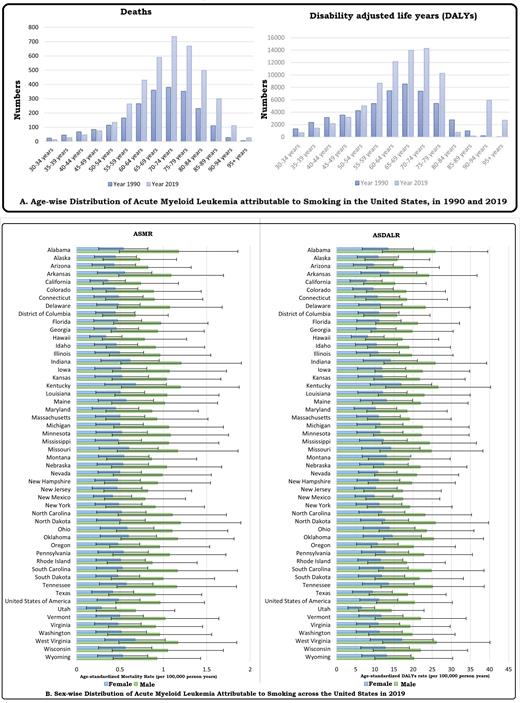Background:
Smoking has long been associated with an increased risk of various cancers, and it
plays a significant role in deaths related to Acute Myeloid Leukemia (AML), accounting
for 1.69% of all cancer-related deaths in the United States of America (USA).
Additionally, among all other risk factors contributing to AML development, smoking is
responsible for a staggering 77.2% of AML-related deaths. However, there is a large
statewide variation within the USA concerning AML burden. Comparable and
consistent state-level measures of total AML burden have not been produced
previously.
Method:
Using the Global Burden of Disease methodology “AML attributable to smoking”
mortality, and disability-adjusted life years (DALYs) were analyzed by age group, sex
and year from 1990-2019 for all residents in the USA using standardized approaches for
data processing and statistical modeling. Results were produced in total number and
age-standardized rate. The findings were reported both in absolute numbers and age-
standardized rates.
Results:
The total number of deaths attributed to AML due to smoking showed an increase from
2,230 (95% uncertainty interval (UI): 1,159-3,275) in 1990 to 3,918 (95% UI: 1,833-
6,003) in 2019. Similarly, the DALYs (Disability-Adjusted Life Years) associated with
AML increased from 52,843 (95% UI: 30,918-75,041) in 1990 to 81,356 (95% UI:
43,328-121,964) in 2019. However, the age-standardized mortality rate (ASMR)
remained relatively stable, with no major difference observed (0.7 deaths per 100,000
95% UI: 0.38-1.02) in 1990 compared to 0.7 (95% UI: 0.35-1.05) in 2019. In contrast
the age-standardized DALYs rate (ASDALR) decreased from 17.51 to 15.3 per 100,000
from 1990 to 2019. Regarding the highest annual percentage of change (APC) in total
number of deaths due to AML, Nevada observed the greatest increase at 275%
followed by Alaska at 236% and Arizona at 179% from 1990 to 2019. In contrast, the
District of Columbia was the only state that showed a decrease in APC for total deaths
with a decline of 6%. Analyzing ASMR, Indiana, and West Virginia observed the highest
APC at 28% each, followed by Kentucky at 23%. Conversely, California experienced the
highest decrease in ASMR APC, showing a decline of 30% from 1990 to 2019.
Regarding age groups, the 95+ age group observed the highest APC increase in ASMR
and ASDALR at 363% and 356%, respectively, followed by the 90-94 age group, which
had an ASMR APC increase of 307% and ASDALR APC increase of 305%. Moreover, males exhibited a higher APC increase in the total number of deaths compared to
females, with percentages of 85% and 62%, respectively, from 1990 to 2019.
Conclusion:
Large disparities in the total burden of AML attributable to smoking persist between US
states despite marked improvements in management. Our findings show that
a substantial proportion of AML cases in the United States are attributed to smoking, making
it a modifiable risk factor for this aggressive hematologic malignancy. Healthcare
professionals and policymakers should utilize this evidence to reinforce anti-smoking
initiatives and raise public awareness about the link between smoking and AML.
Disclosures
No relevant conflicts of interest to declare.


